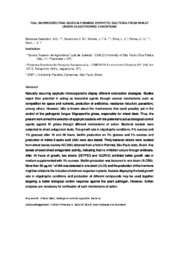Bioprospecting biofilm-forming epiphytic bacteria from wheat under oligotrophic conditions.
Bioprospecting biofilm-forming epiphytic bacteria from wheat under oligotrophic conditions.
Author(s): CASTELIANI, A. G. B.; KAVAMURA, V. N.; MORAIS, J. F. A.; SILVA, J. L. da; PANSA, C. C.; MELO, I. S. de
Summary: Abstract: Naturally occurring epiphytic microorganisms display different colonization strategies. Studies report their potential in acting as biocontrol agents through several mechanisms such as competition for space and nutrients, production of antibiotics, resistance induction, parasitism, among others. However, little is known about the mechanisms that could possibly act in the control of the pathogenic fungus Magnaporthe grisea, responsible for wheat blast. Thus, the present work aimed the selection of epiphytic bacteria with the potential to act as biological control agents against M. grisea through different mechanisms of action. Bacterial isolates were subjected to direct antagonism tests. The growth rate in oligotrophic conditions (1% sucrose and 1% glucose) after 14 and 36 hours, biofilm production on 1% glucose and 1% sucrose and production of indole-3-acetic acid (IAA) were also tested. Thirty bacterial strains were isolated from wheat leaves (variety IAC 385) obtained from a field in Palmital, São Paulo state, Brazil. Any isolate showed direct antagonistic activity, indicating that no inhibition occurs through antibiosis. After 14 hours of growth, two strains (2EPPE3 and 1LCR10) exhibited better growth rate in medium supplemented with 1% sucrose. Biofilm production was favoured in one strain (1LCR3). More than 50 ?g.mL-1 of IAA was detected in one strain (1L10) and the production of this hormone might be related to the induction of defence response in plants. Isolates displaying the best growth rate in oligotrophic conditions and production of different compounds may be used together targeting a better biological control response against the plant pathogen. However, further analyses are necessary for verification of such mechanisms of action.
Publication year: 2015
Types of publication: Abstract in annals or event proceedings
Unit: Embrapa Environment
Keywords: Biological control, Epiphytic bacteria, Wheat blast
Observation
Some of Embrapa's publications are published as ePub files. To read them, use or download one of the following free software options to your computer or mobile device. Android: Google Play Books; IOS: iBooks; Windows and Linux: Calibre.
Access other publications
Access the Agricultural Research Database (BDPA) to consult Embrapa's full library collection and records.
Visit Embrapa Bookstore to purchase books and other publications sold by Embrapa.

